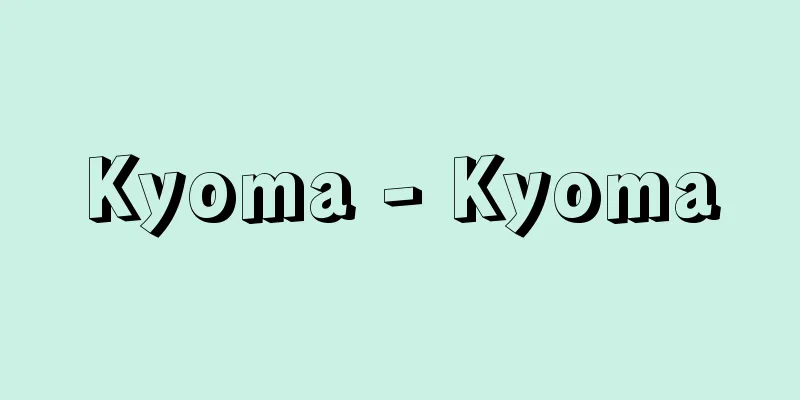Xinhai Revolution

|
A bourgeois democratic revolution in China that began in 1911 (the year of Xinhai). This revolution brought an end to the Qing Dynasty, which had lasted for about 300 years, and marked the end of 2000 years of tyranny. The Republic of China was born, and the foundations of democratic republican politics were established. It is also called the Republican Revolution or the First Revolution. [Yutaka Nozawa] Pre-revolutionary historyThe Xinhai Revolution originated from the decline of the Qing dynasty, which was established by the Manchu ethnic minority, and the defection of the Chinese people, mainly the Han people. Starting with the White Lotus Rebellion, and going through various incidents at the end of the Qing dynasty, including the Boxer Rebellion, the growing aggression of the great powers, and the deepening threat of colonization of China, the Qing dynasty had to reconstruct its centralized system in order to survive, while strengthening its dependence on the outside world. A new government movement was launched, which included system reform, constitutional preparations, encouragement of business, and strengthening of the military, but due to financial difficulties, it became unavoidable to increase old taxes and establish new taxes, which intensified social contradictions and led to the development of mass protests nationwide, including opposition to the new government, non-payment of taxes, demands for rice, and the recovery of vested interests. Along with this, a constitutional faction was formed based on local influential people (town gentry) and the business community, and a movement was launched for the early opening of the National Assembly with the aim of establishing a constitutional monarchy. On the other hand, revolutionaries including Sun Yat-sen formed the China Tongwen Society in 1905 based on overseas Chinese, part of the business community, students studying in Japan, and young intellectuals in the country. Aiming to realize a democratic republic, they teamed up with the Huidang (secret society) and waged an armed struggle against the Qing Dynasty, mainly in central and southern China, but they ended up with repeated failures. [Yutaka Nozawa] The course of the revolutionIn May 1911, the Qing Dynasty, which was in financial difficulty, issued the Railway Nationalization Order, nationalizing the privately operated railways and using them as collateral to borrow a large amount of money from the Shikoku Loan Association, an alliance of financial capitalists of the great powers. In response to this, widespread opposition movements were aroused in Hunan, Hubei, Guangdong, and other areas, and in Sichuan, this escalated into a large-scale armed struggle (the Sichuan Uprising). In early October, when the Hubei New Army was mobilized to subjugate Sichuan, the revolutionaries who had formed the Literature Society and the Gongjin Society in the Wuhan area and carried out revolutionary operations against the army and had a large influence within the Hubei New Army finally rose up in Wuchang on October 10, established the Republic of China Military Government, and started the Xinhai Revolution (the Wuchang Uprising). The revolutionary wave quickly swept across the country, and within a month most provinces had responded by declaring independence. The revolutionaries struggled against a counterattack by the Qing army in the Wuhan area, but they captured the Nanjing area, gathered representatives from each province, welcomed Sun Yat-sen, who had been raising military funds overseas, and established the Nanjing Provisional Government with Sun Yat-sen as Provisional President on January 1, 1912, and launched the Republic of China. Sun Yat-sen said that the issues facing a "government in the revolutionary era" were the unification of ethnic groups, territory, military administration, internal governance, and finances, but with the great powers of Japan and Britain and other external forces, and the constitutionalists who held key positions in the provisional government at home, as well as internal conflicts among the revolutionaries, it became difficult to carry out the revolution thoroughly through the "Northern Expedition," and so efforts were made to reach a peace agreement between the North and South. Prior to this, the Qing dynasty appointed Yuan Shikai of the Beiyang warlords and ordered him to suppress the revolutionary forces, but Yuan Shikai, who organized a cabinet and seized both military and political power, planned a peace treaty with the mediation of the UK, and in exchange for the abdication of the Qing dynasty's Emperor Xuantong, took the position of provisional president from Sun Yat-sen, and formally became the provisional president on March 10th, launching the Beijing government. The revolutionaries promulgated the "Provisional Constitution of the Republic of China" in Nanjing the following day in an attempt to legally bind Yuan Shikai. This could be called a draft constitution, but it was epoch-making in that it stipulated that sovereignty resides with the people and that the people have the right to freedom and equality. It also introduced a responsible cabinet system and granted great power to the Prime Minister in an attempt to prevent the arbitrary decisions of the President. On April 1, Sun Yat-sen officially resigned, and on the 5th it was decided to move the provisional government to Beijing, marking the end of the "revolutionary era." [Yutaka Nozawa] The Rise of Yuan Shikai and the End of the RevolutionWhen power was handed over to Yuan Shikai, radical revolutionaries such as Sun Yat-sen sought to promote business and social reform from an oppositional position, while moderate elements such as Song Jiaoren actively participated in politics, hoping to establish a multiparty system and realize a responsible cabinet system, but the central political situation in the early days of the Republic of China unfolded as a struggle over party politics. Amid the proliferation of political parties that accompanied the founding of the Republic of China, which was based on a constitutional republic, Song Jiaoren and others reorganized the China Tongminghui into an open political party, and then combined smaller parties to form the Kuomintang, aiming to realize party politics. When the Kuomintang won the parliamentary elections held in January-February 1913, Yuan Shikai, with the support of the great powers and the constitutionalists, used force to suppress the Kuomintang, leading to the assassination of Song Jiaoren, and at the end of April, he concluded a large loan of 25 million pounds with the Five Power Loan Commission, thus winning the Second Revolution. Having suppressed the revolutionaries, Yuan Shikai continued his imperialist movement while accepting Japan's Twenty-One Demands, which sparked the Third Revolution. This ended with Yuan's death, but China fell into a state of chaos between warlords, and the Xinhai Revolution came to an incomplete end, with the anti-imperialist, anti-feudal agenda continuing in subsequent struggles. [Yutaka Nozawa] ``The Xinhai Revolution'' by Yutaka Nozawa (Iwanami Shinsho)'' ▽ ``The Origins of the Modern Chinese Revolution'' by Takaharu Kikuchi (1970, Gannando Shoten) ▽ ``The Xinhai Revolution'' by Yuzhang Wu (1960, Gaibun Publishing) ▽ ``The Chinese Revolution Military Story'' by Toutian Miyazaki (1967, Hosei University Press)'' ©Shogakukan "> Xinhai Revolution (Revolutionary Military Government and Independent Province) Source: Shogakukan Encyclopedia Nipponica About Encyclopedia Nipponica Information | Legend |
|
1911年(辛亥(かのとい)の年)に起こされた中国のブルジョア民主主義革命。この革命により、300年ほど続いた清(しん)朝が滅び、2000年来の専制政治が終わりを告げて、中華民国が生まれ、民主共和政治の基礎がつくられた。民国革命、第一革命ともよばれる。 [野澤 豊] 革命前史辛亥革命は、少数民族である満洲族のつくった清朝の衰退と、漢民族を中心とした中国民衆の離反に由来する。白蓮(びゃくれん)教の乱に始まり、清末の諸事件を経て、義和団事件が起こされ、列強の侵略が強まり、中国の植民地化の危機が一段と深まるなかで、清朝は対外従属を強めつつ、自らの存続のためには、中央集権体制の立て直しを図らねばならなかった。制度改正、立憲準備、実業奨励、軍備強化などを内容とする新政運動が起こされたが、財源難のため、旧税の増徴と、新税の増設が不可避となり、社会的矛盾を激化させることとなって、新政反対、税金不払い、米よこせ、利権の回収などといった大衆闘争の全国的な展開をもたらすに至った。それに伴い、一方で、地方の有力者(郷紳(きょうしん))や商工界を基盤に立憲派が形成されて、立憲君主制を目ざした国会速開の運動が起こされた。他方では、華僑(かきょう)のほか、商工界の一部、留日学生や、国内の知識青年層を基盤として、孫文(そんぶん/スンウェン)ら革命派が1905年に中国同盟会を結成し、民主共和の実現を目ざして、会党(秘密結社)などと組み、反清武装闘争を華中・華南地方を中心に繰り広げていったが、失敗の繰り返しに終わっていた。 [野澤 豊] 革命の経過1911年5月、財政難に陥った清朝は鉄道国有令を出し、民営であった鉄道を国有化して、これを担保に列強金融資本の連合体である四国借款団から多額の金を借り受けようとした。これに対して、湖南(こなん/フーナン)、湖北(こほく/フーペイ)、広東(カントン)などで広範な反対運動が起こされ、四川(しせん/スーチョワン)では大規模な武装闘争に発展した(四川暴動)。10月初め、四川討伐に湖北新軍が動員されるに及び、武漢地区で文学社や共進会などを組織し、軍隊に対して革命工作を行い、湖北新軍内に大きな勢力を張っていた革命派は、ついに10月10日武昌(ぶしょう/ウーチャン)に蜂起(ほうき)し、中華民国軍政府を設けて、辛亥革命の口火をきった(武昌蜂起)。革命の波はたちまち全国を巻き込み、1か月内にほとんどの省が呼応して、独立を宣言するに至った。 革命派は、武漢(ぶかん/ウーハン)地区で清軍の反撃を受けて苦戦したが、南京(ナンキン)地区を攻略し、各省代表を集め、海外で軍資金の募集にあたっていた孫文を迎えて、1912年1月1日に孫文を臨時大総統とする南京臨時政府をたて、中華民国を発足させた。孫文は、「革命時代の政府」の課題は民族、領土、軍政、内治、財政の統一にあるとしたが、外からは日本、イギリスなど列強が、内では臨時政府の要職を占めた立憲派などが策動し、革命派の内部対立もあって、「北伐(ほくばつ)」による革命の徹底化は困難となり、南北和議が図られることになった。これより先、清朝は北洋軍閥の袁世凱(えんせいがい)を起用し、革命軍の討伐を命じたが、内閣を組織して軍政両権を掌握した袁世凱は、イギリスの仲介で和平を画策し、清朝の宣統帝の退位と引き換えに、孫文から臨時大総統の地位を奪い、3月10日正式に大総統に就任して、北京(ペキン)政府を発足させた。革命派は、袁世凱に法制的な拘束を加えようと、その翌日、南京で「中華民国臨時約法」を公布した。これは憲法草案ともいうべきものであるが、主権在民と、人民の自由・平等の権利を規定した点において、画期的意義をもつものであった。また、責任内閣制を取り入れて、国務総理に大きな権限を付与することで、大総統の専断を予防しようとした。4月1日、孫文は正式に辞任し、5日に臨時政府の北京移転が決定され、「革命時代」は終わりを告げた。 [野澤 豊] 袁世凱の登場と革命の終焉袁世凱への政権委譲にあたって、孫文ら革命派の急進分子は、在野の立場にたって実業振興と社会改革を目ざそうとし、宋教仁(そうきょうじん/ソンチャンレン)ら穏健分子は積極的に政治に関与し、多数政党の樹立と責任内閣制の実現を望んだが、民国初期の中央政局は政党政治をめぐる抗争として展開されていった。立憲共和制をたてまえとした中華民国の発足に伴う政党乱立のなかで、宋教仁らは中国同盟会を改組して公開政党とし、ついで小党派をあわせて国民党をつくり、政党政治の実現を目ざした。1913年1~2月施行された国会選挙で国民党が勝利するに及び、袁世凱は列強や立憲派の支持の下に、これに武力弾圧を加え、宋教仁暗殺事件を引き起こし、4月末に五国借款団との間に2500万ポンドに上る善後大借款を結び、第二革命に勝利した。革命派を押さえた袁世凱は、帝制運動を進める一方で、日本の対華二十一か条要求を受諾したことから、第三革命が起こされた。これは袁の死で終わったものの、これより中国は軍閥混戦状態に陥り、辛亥革命は不徹底なまま終わりを告げ、反帝反封建の課題はこれ以後の闘争に引き継がれていった。 [野澤 豊] 『野澤豊著『辛亥革命』(岩波新書)』▽『菊池貴晴著『現代中国革命の起源』(1970・巌南堂書店)』▽『呉玉章著『辛亥革命』(1960・外文出版社)』▽『宮崎滔天著『支那革命軍談』(1967・法政大学出版局)』 ©Shogakukan"> 辛亥革命(革命軍政府と独立した省) 出典 小学館 日本大百科全書(ニッポニカ)日本大百科全書(ニッポニカ)について 情報 | 凡例 |
<<: Deep-sea fish - Shinkaigyo (English spelling)
Recommend
Pulling (pulling) - Pulling
A type of additional punishment in which a prison ...
Continued Japanese Ojoden - Zokuhonchooujoden
This work follows on from Nihon Ojo Gokurakuki and...
Theodosian Dynasty - Theodosius
The period refers to the period following the deat...
Luminosity scale - luminosity scale
Star classification usually refers to the classifi...
Flower Clock
Flowers of plants bloom at roughly the same time ...
Nishisonogi Peninsula
A peninsula that juts out from the northern part ...
Utagarasu - Utagarasu
A type of karuta game based on waka poetry. 100 w...
Karubin - Karyobin
...The name of Gagaku, Bugaku, and Kangen music. ...
Lithopone - Lithopone (English spelling)
A white pigment made from a mixture of zinc sulfi...
Asamushi [Hot Springs] - Asamushi
Located in the eastern suburbs of Aomori City, Aom...
Vulvar cancer - vulvar cancer
A general term for cancers occurring in the female...
The Eighteen Great Streets
He was a wealthy playboy who appeared in Edo duri...
Europhielia
…(3) South Africa and Madagascar There are few ge...
Osaka City University
It is a public university corporation. It origina...
vijñāna (English spelling) vijnana
…In ancient India, the word manas (translated int...









